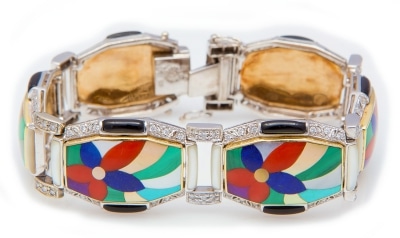

You probably know that enamel is the shiny, white material that covers your teeth, but did you know that enamel is also used in jewelry? They’re not the same kind of enamel, of course, as the stuff on your teeth occurs naturally inside the human body, while enameled jewelry is created with powdered glass and lots of heat.
Your fine jewelry store in Austin, Copeland Jewelers, offers many varieties of enameled jewelry as well as expertise in enamel jewelry repair.
Read on to learn how enamel jewelry is made!
What Is Enamel and Where Did It Come From?
The material we’re discussing here is known as “vitreous enamel” or “porcelain enamel” (in order to differentiate it from the stuff on your teeth!).
Enameling began around 4 B.C. and was a popular decorative art among the ancient Greeks, Egyptians, Chinese, Celts, and other groups. Many different materials can have enamel applied to them, including stone, glass, pottery, and of course, metal, which is the base of most enameled jewelry.
Many different techniques have been used over the centuries, but the basic method is to apply very finely powdered glass to the object that is going to be decorated and apply very strong heat in a controlled manner.
How Enamel Is Made
Today, artists who work with enamel are able to create more than two hundred different colors.
Each shade begins with an incredibly fine powder that basically just looks white, like baby powder, whether or not white is the color that will be produced by that particular blend of powder. The surface of the metal is cleaned, and then the powder is either kept dry and sifted onto the piece of jewelry, or it will be wet-packed into small spaces in the metal.
Depending on the final look that the artist wants to achieve, these two basic techniques can be slightly modified.
Heat will be applied either with a hand torch, with a kiln, or with a combination of the two tools. Enamel is generally heated between 1,380 and 1,560 degrees Fahrenheit – this is enough to melt the glass powder without melting the metal base of the jewelry.
There are four different finishes for enamel, depending upon the desired look for the final piece:
- “Sugar,” which is lightly bumpy, like fine sugar, and not shiny.
- “orange peel,” which is glossy and bumpy, like the peel of citrus fruit.
- “full fuse,” with a smooth and shiny surface.
- “over fired,” which is shiny but pitted, possibly flecked with black spots, and the edges may change color.
All four of these finishes can be beautiful in different settings.
Look To Copeland Jewelers For Fine Enamel Jewelry
Our jewelry enthusiasts love enamel because it offers so many wonderful options for creating unique pieces.
Our Enameled work can be done in one single color, or it can swirl two or more colors together like marble, or it can feature multiple colors pieced together to create an image or pattern, much like squares of a quilt. However our enameled work is designed and completed, it creates a lovely, unique work that will stand the test of time.
Come into Copeland Jewelers today to discover our wide selection of enamel jewelry!
